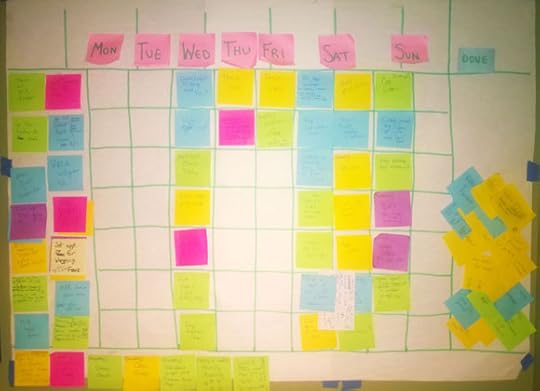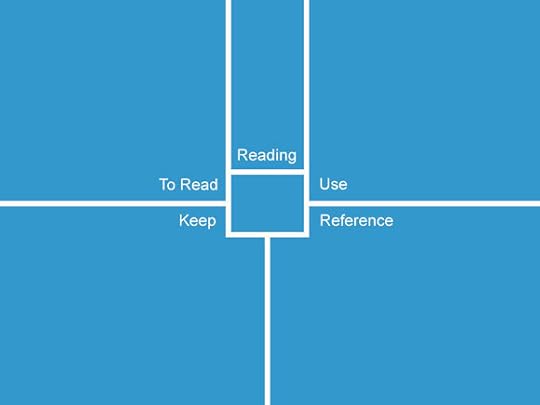Marina Gorbis's Blog, page 1320
February 12, 2015
What Chinese Companies Want from International Deals

If you’re one of the many managers out there who must negotiate with companies in China — the world’s largest emerging economy — you probably need to change your approach. What worked a year or two ago is no longer effective, because the competitive and regulatory environment has transformed so quickly.
Last year China’s outbound foreign direct investment (FDI) surpassed its inbound FDI for the first time. That’s a big shift from the beginning of the millennium, when the government courted investors who could bring in capital, manufacturing knowhow, and jobs. Chinese companies are looking for different things now, and it’s critical to know what those are if you want to make your firm a more attractive investor, partner, or acquisition target in China. They’re focusing on three things these days:
Resources. Chinese companies want access to energy, raw materials, and food that will support growth in their economy and in their customers’ needs—especially at the high end. Consider, for example, Shineway’s recent purchase of Smithfield, a major U.S. producer of pork. This acquisition was motivated by China’s increased demand for pork and Smithfield’s reputation for high-quality, safe products (especially important given recent food scares related to sick hogs and bird flu). Buying Smithfield allowed Shineway to sell pork in the Chinese market at a premium price.
Technology. Companies in China are also on the lookout for technology that will help them expand. In 2010 no one was interested in the Swedish car maker Volvo—except Geely, a low-end Chinese car maker that realized it could enter the middle and higher-end markets and increase its margins by acquiring Volvo’s technology and brand (renowned for safety). The acquisition was a huge success. Geely launched new models at around double the price of its other cars.
Access to mature global markets. Lenovo bought IBM’s PC business in 2004 (and its x86 server business in 2014) for access to brands and customer relationships in mature markets in developed countries. This benefited Lenovo in two ways: First, the investments increased its profit margins. Second, by combining its constantly growing Chinese markets with the x86 server’s mature markets, Lenovo became the largest server supplier in China and the third largest in the world. That brought advantages of scale, such as lower costs and better integration across its businesses. Lenovo recently acquired Motorola’s cell phone patents and R&D labs, as well. Time will tell if this move will help Lenovo break into the global smartphone market the way its IBM acquisitions gave it a foothold in PCs and servers.
Knowing that Chinese companies are seeking resources, technology, and access to mature global markets puts you in a better position to negotiate with them. So determine what you have to offer in these areas. After all, being able to satisfy others’ interests is a fundamental source of power in negotiations.
It’s also essential to know your competition, as it is in any deal-making situation. What other companies can satisfy the needs that you are trying to meet? How is what you have to offer better? To be sure, deeper resource reserves, superior technology, and higher margins will make you stand out in China, but don’t ignore the value of taking the time to build a trusting relationship with your potential Chinese partner and capitalizing on your reputation for integrity.
Finally, identify what you want in return — and don’t lose sight of it. Some Chinese companies may be better at meeting your needs than others. It will strengthen your position in negotiations to know about multiple firms you could collaborate with.


[image error]
Stop Making Excuses for Your Flawed Data

Most managers readily admit that their organizations’ databases are rife with errors that add time and expense to day-in, day-out work. Most even suspect that these problems have grown worse, not better, with the explosive growth in data. Yet they believe — or hope — that these issues won’t affect them when it comes to planning and decision-making for their company.
Unfortunately, this hope is unfounded. Data quality problems bedevil managers in every industry, company, business unit, department, and process. If anything, these problems grow worse when executives use the data to inform high-level decisions. After all, an error in a customer database only fouls up a transaction or two. But aggregated bad data can send a decision awry and hurt the company for years.
Recognizing that you have a problem is the first step, so ask yourself the following questions:
Do I really have all the data I need to make an informed decision?
Do I understand what the data really mean?
Can I trust the data in making this decision?
When I do trust the data, is that trust justified?
Data quality issues come in many forms — from not having the data you really need, to data that are easy to misinterpret, to data that simply can’t be trusted. Worst are the data quality problems that you don’t even know you have. Unfortunately, they are all too common.
The first category, not having the data you really need, involves missing the key facts or not having the complete picture. It happens a lot, often with key performance measures. One good example occurs when a company needs to speed up a multi-step process. Managers of each step may have a good handle on the cycle time associated with their respective steps, but senior managers may still not know how long it takes to complete the entire process. The gap occurs because queue time, the time spent between steps, is not measured.
And, lacking this data, managers can’t make good decisions about how or how much to reduce cycle time. This is a big deal: When the queue time is high, creating better interfaces between steps can yield huge reductions in cycle time. If the queue time is low, the actual work within steps must be made quicker.
A second common problem involves misinterpreted data, which can include anything from sloppy definitions to misunderstood algorithms. A classic example is when you ask, “How many customers do we have?” and the answer is “That depends on what you mean by ‘customer.’”
Or, consider a company I worked with that focused its marketing and sales efforts on market share. Each week it took a careful look at the effectiveness of last week’s efforts, comparing last week’s market share with the previous week’s. This company, though, was concerned that there was noise in weekly data, so they employed a smoothing algorithm to fix it. In doing so, they perverted the intent of the effectiveness metric, which produced numbers that were downright misleading. A notable gain in market share was reported as an insignificant one.
Note the impact: Gains in market share are hard to come by. When they occur, a company wants to build upon, or at least protect, them. So a huge reported gain will lead the company to study the week in great depth, seeking to understand the contributions to share gain from its actions (such as promotions) that week, residual effects of earlier actions, competitor error, and so forth (even though there is uncertainty surrounding this estimate). But a tiny gain will garner little attention — and an enormous opportunity is wasted.
I call the third category, “you can’t trust the stuff.” You have the data you need and feel certain you understand what it means. But you don’t feel confident that the data are accurate enough, and instinctively perhaps, you remove it from your decision-making calculus.
It’s particularly disheartening when a big data analysis yields a stunning new insight. But the big data team spent 90% of its time cleaning up the data. You know they did the best they could, but you’re uncertain they got enough of the errors. Can’t trust the data, can’t trust the analysis, can’t trust the insight!
While any of these issues can be showstoppers, they are even more insidious and pernicious when you don’t know you have them. You think you have the complete picture, that you understand what the data mean, and that they are trustworthy, but something is radically wrong. The company investigating market share is a perfect example. It had gone to great trouble to ensure it was dealing with high-quality data, blissfully unaware that it had created an even larger issue for itself.
I run into this problem all too frequently and at all levels — a hiring manager thinks he has a full view of the candidate; the operations manager thinks her budget numbers are up-to-date; the IT manager who thinks he understands the full price for an enterprise systems; the finance manager thinks there will be no further significant charges to the previous quarter. And sometimes things turn out fine. The candidate turns out to be a better employee than the manager had hoped or costs come in lower than expected. But more often the decision is suboptimal. This is no way to run a company.
One may argue that the essence of managerial work is making good decisions in the face of uncertainty and that bad data is just another source of uncertainty. That argument strikes me as sheer folly, particularly since it doesn’t have to be that way. The prescriptions for making wholesale improvements work quite well. Even better, they can be applied by any manager, at any level, in any role, at any company.
It is time for managers to recognize that doing their best in light of poor data is no longer acceptable. Decision making is just so much more effective when you have a complete, trusted, fully-understood picture.


[image error]
February 11, 2015
Don’t Waste Those 30-Minute Gaps Between Meetings

We all have 30-minute gaps in our work schedules that we neither planned nor agreed to. We can blame the automated scheduling platforms that companies implemented in the 1990s and 2000s for that. These systems — most notably Microsoft Office — have had unintended consequences on our time: meetings are often scheduled far into the future, more people attend, and — possibly the most frustrating consequence of all — 30-minute gaps are scattered throughout our day. The systems that were developed to improve our efficiency are, in fact, killing our productivity. We have literally handed over control of what is on our daily calendar, who we meet with Monday morning, in what order or cadence we go about our work day. It is time to take back control — at least where we can.
We don’t often pay attention to the 30-minute gaps sandwiched between two meetings. For most, they just mean there’s some breathing room before the next meeting starts. Time to grab a quick coffee and maybe answer a few emails. On any given day, that might seem harmless, but if you take a long-term view of your month, quarter, or year, these 30-minute spaces can have a real toll on your productivity: four 30-minute gaps in your schedule can add up to 25% of your day. It pays to think differently about this floating space of time. It is there for us if we choose to use it; to write it off as a waste of time is a missed opportunity. Here’s how to take some of your time back:
Take a few minutes at the start of each day to identify the gaps in your schedule.
Schedule what you want to accomplish in each gap right on your calendar. This can be anything from lower value work that needs to get done (such as expense reports) to larger, finite tasks you’ve been dreading (such as outlining your next presentation).
Hold yourself accountable. At the end of the day, look back on your 30-minute tasks and note which ones you’ve accomplished.
You and Your Team
Getting More Work Done
How to be more productive at work.
These small spaces of time are also good for the kind of work you want to come back to and reflect on, like writing an article or a creative pursuit. For instance, I recently started planning for a large project. I used a 30-minute block to start to draft the project charter statement. Later in the week, I revisited the draft. The passage of just a few days helped me gain perspective. When I revisited the charter, I was able to reshape part of the scope.
So stop looking at those 30-minute gaps in your day as a waste of time. They may be the key to turbocharging your productivity.


[image error]
There Are Risks to Mindfulness at Work

Mindfulness is close to taking on cult status in the business world. But as with any rapidly growing movement—regardless of its potential benefits—there is good reason here for caution.
Championed for many years by pioneering researchers such as Ellen Langer and Jon Kabat-Zinn, mindfulness is a mental orientation and set of strategies for focusing one’s mind on here-and-now experiences, such as abdominal muscle movements during respiration or chirping of birds outside one’s window. It is rooted in ancient Eastern philosophies, such as Taoism and Buddhism. Contemporary empirical research demonstrates its benefits for reducing anxiety and mental stress. A recent study suggested that it might cut the risk of stroke and heart attack as well.
Mindful meditation and other related practices are now widely accepted. The New Republic published an article entitled “How 2014 Became the Year of Mindfulness.” Mindfulness has recently been featured on CBS’ 60 Minutes, and lauded by the Huffington Post. Dan Harris, a well-known ABC News correspondent, published a best-selling book called Ten Percent Happier, which describes his journey to discovering mindful meditation as optimal management for his very publicly shared anxiety disorder. There is increasing interest in how mindfulness can be applied in clinical medicine and psychology, and even large insurance companies are beginning to consider providing coverage for mindfulness strategies for certain patients.
As an executive coach and physician, I often sing the praises of mindfulness approaches and recommend them to clients to manage stress, avoid burnout, enhance leadership capacity, and steady their minds when in the midst of making important business decisions, career transitions, and personal life changes. Drawing on concepts of Eastern philosophies and research evidence from contemporary neuroscience, I help some clients to employ controlled breathing and similar strategies in our sessions and in their everyday lives. In addition, I refer many clients to trusted colleagues who teach them yoga and mindful meditation in greater depth than I can provide in my coaching sessions.
But my growing knowledge of (and enthusiasm for) mindfulness is now tempered by a concern about its potential excesses, as well as the risk that it’s crowding out other equally important models and strategies for managing stress, achieving peak performance, and reaching professional and personal fulfillment. At times, it appears that we are witnessing the development of a “cult of mindfulness” that, if not appropriately recognized and moderated, may result in an unfortunate backlash against it. Here are a couple of my concerns:
The avoidance risk. Some people use mindfulness strategies to avoid critical thinking tasks. I’ve worked with clients who, instead of rationally thinking through a career challenge or ethical dilemma, prefer to disconnect from their challenges and retreat into a meditative mindset. The issue here is that some problems require more thinking, not less. Sometimes stress is a signal that we need to consider our circumstances through greater self-reflective thought, not a “mindful” retreat to focused breathing or other immediate sensory experiences. Mindfulness strategies can prime the mind for sounder rational thinking—but the former clearly should not displace the latter. One of my clients spent so much time meditating and “mindfully” accepting her life “on its own terms” that she failed to confront underperforming workers (and discipline or fire the worst offenders) in her company. After periods of meditating, she struggled to return to focused, task-oriented thinking. She required significant reminders and reassurance from me that embracing Buddhist meditation does not entail tolerating substandard performance from her employees. Mindful meditation should always be used in the service of enhancing, not displacing, people’s rational and analytical thought processes about their careers and personal lives.
The groupthink risk. As mindfulness practices enter mainstream American life, some organizations and companies are admirably encouraging their people to make use of them in the workplace. But I’m aware of situations where this new orientation has gone too far. In one case, the director of a business unit in a financial services corporation required his direct reports to participate several times per week in a 10-15 minute mindfulness session involving controlled breathing and guided imagery. Many participants came to dread the exercise. Some of them felt extremely awkward and uncomfortable, believing that mindfulness practices should be done in private. The very exercise that was supposed to reduce their work-related stress actually had increased it. The practice continued for weeks until several members of the group finally gathered the courage to tell the group leader that they would strongly prefer the daily exercises be optional, with impunity for non-participants. Mindfulness is rooted in a philosophy and psychology of self-efficacy and proactive self-care. Imposing it on people in a top-down manner degrades the practice and the people who might benefit from using it of their own volition.
There is no denying that mindfulness has emerged as a major cultural phenomenon on the contemporary American scene and in the business world in particular. That can be good news for people dealing with stress, burnout, and other realities of the modern workplace. But mindfulness practices need to be incorporated as one among many self-chosen strategies for people aiming to cope with stress, think effectively, make sound decisions, and achieve fulfillment. Mindfulness practices should be used to enhance our rational and ethical thinking processes, not limit or displace them. And mindfulness practices should never be imposed on other people, especially in the workplace. At its very core, mindfulness culture will be a huge step forward for Western cultures if it stays focused on creating opportunities for individuals to discover their own personalized strategies for taming anxieties, managing stress, optimizing work performance, and reaching genuine happiness and fulfillment.


[image error]
The Enemies of Data Security: Convenience and Collaboration

It is natural to view IT as both the cause and the cure for cyber security problems. After all, attackers typically steal information by exploiting a technology-related vulnerability. In addition, IT networks are usually the scene of the crime, and their inner workings are a mystery to most users and therefore a focus of suspicion. It is also tempting to believe that using sophisticated security devices alone will offer protection from cyber threats. However, such a view ignores fundamental drivers of information security risk: organizational culture and the behaviors that result from it.
Two aspects of a company’s culture have outsized effects on the security of its information: the organization’s tolerance for inconvenience and the degree of collaboration across business units and among employees.
Security and convenience are inversely related. The greater the security provided by a control, the less convenient it is for affected individuals. For example, just as adding locks requires extra keys, increasing password complexity results in additional memorization and typing. An organization’s willingness to tolerate inconvenience has a profound effect on the security of its information.
Importantly, its most senior employees, the leaders who define and shape the organization’s culture, often have the lowest tolerance for inconvenience. An extreme example I encountered was a prestigious law firm where the senior partners refused to use passwords! To quote David Halberstam writing about political leaders, “They were brilliant and they were fools.”
A culture of failing to make security measures a priority is a particular problem in mission-driven organizations. Activities that contribute in obvious and direct ways to the mission are automatically prioritized over practices that are viewed as irrelevant — or as impediments — to it. In such cultures, employees often have tacit, if not explicit, approval to deploy the most expedient information management solution to the exclusion of more secure but less convenient alternatives. What makes these companies successful, the strength of their commitment to the mission, also puts them at risk.
Organizations that operate as a collection of independent business units have a different cultural problem relative to information security. They may be structured this way because they have grown through acquisition or because their business models or customers differ from one another. Either way, it can be difficult to maintain communication and consistent standards in these organizations. This can result in disjointed security solutions that are difficult to manage, thereby increasing risk.
That said, organizations with collaborative cultures are also prone to high-risk information management practices. For example, academic institutions actively encourage “promiscuous” behavior to promote knowledge sharing. Even sophisticated technology companies are not immune as their youthful cultures tend to resist information technology restrictions.
In the event of a data breach, the IT department is usually blamed for failing to control the security of the organization’s information, when in fact the prevailing culture throughout the organization has undermined IT’s risk-management efforts. There’s a structural problem as well: the IT department is often responsible for both technology implementation and IT security governance, a situation that often puts IT staff in invidious positions and represents an inherent conflict of interest.
Given the cultural drivers of information security risk, how can organizations be more effective in addressing the spectrum of cyber threats that exist today?
Changing an organization’s culture is admittedly not easy. This is especially true if the very features that have contributed to its historical success also put it at risk. The answer is not to destroy the existing culture, but rather to infuse security into the organizational DNA and to support those responsible for implementing secure technology solutions in spite of encumbrances that result from user inconvenience. Importantly, the message must emanate from the top, and senior executives must lead by example.
The good news is that measurements can be made that will yield meaningful if coarse data about the security culture and how resistance to basic security controls is changing over time.
First, periodically testing the user population on the contents of the information security policy is a direct measurement of the effectiveness of security governance. This policy should be simple, non-technical, risk-based, aggressively disseminated, and demonstrably assimilated across the organization. An enterprise information security policy is essential to a strategic approach to managing information security risk as it specifies the ground rules for proper employee behavior and aligns disparate businesses with the organization’s overarching security strategy.
The information security policy should be linked to a set of technical and operational standards based on the actual risks to the business and formulated by subject matter experts. The policy dictates what security processes are required, and standards indicate how such processes must be implemented and followed.
Second, measuring password resilience is a good if indirect indicator of the prevailing culture. If passwords are easily cracked or are not regularly changed, then either the culture as reflected in policy is too tolerant or users are at liberty to disobey the policy. In general, the quality and staleness of passwords tell a lot about whether security or convenience is the dominant cultural theme.
Information security affects, and is affected by, all individuals in an organization, and seemingly trivial errors by a single user can have existential consequences. In the end, what’s most important is that employees believe that by complying with information security standards and policy they are reinforcing their organization’s culture, rather than undermining it.


[image error]
5 Ways to Become More Self-Aware

You can’t be a good leader without self-awareness.
It lies at the root of strong character, giving us the ability to lead with a sense of purpose, authenticity, openness, and trust. It explains our successes and our failures. And by giving us a better understanding of who we are, self-awareness lets us better understand what we need most from other people, to complement our own deficiencies in leadership.
The question, then, is how can we cultivate and develop it further. There are many ways to do so. Below are five that I have found to work best:
Meditate. Yes, meditate. As most people know by now, meditation is the practice of improving your moment-by-moment awareness. Most forms of meditation begin with focusing on, and appreciating the simplicity of, inhaling and exhaling. But these don’t need to be formal or ritualistic — greater clarity can also come from regular moments of pause and reflection. Speaking personally, I try to gain greater awareness by simply finding a few seconds to focus on my breathing, often before sleep, and sometimes with one of the many apps available to help. During these meditations, I also ask myself a set of questions, among them:
What am I trying to achieve?
What am I doing that is working?
What am I doing that is slowing me down?
What can I do to change?
But the most frequent form of “meditation” I practice derives from carrying out seemingly mundane tasks that inspire a degree of therapeutic serenity, including washing dishes, working in my garden, and spending early Saturday mornings writing in Boston’s Museum of Fine Arts as I wait for my son to be dismissed from his drawing class.
Write down your key plans and priorities. One of the best ways to increase self-awareness is to write down what you want to do and track your progress. Warren Buffet, for one, is known for carefully articulating the reasons he’s making an investment at the time he makes it. His journal entries serve as a historical record that helps him assess whether or not future outcomes can be attributable to sound judgment or just plain luck.
Li Lu, a co-leader of the Tiananmen Square student demonstration and today a highly respected investor, told me once about a practice he followed for years, inspired by Benjamin Franklin. Franklin kept a “balance sheet” of both the assets and liabilities of his personal traits. By diarizing any new strength he believed he could learn from someone else, and marking down any self-perceived weaknesses, he could better assess whether the “net worth” of his character was growing over time.
Take psychometric tests. In Heart, Smarts, Guts and Luck, my co-authors and I developed a simple “entrepreneurial aptitude test” in order to understand which traits readers were most likely to be biased in business-building and in life. Among the best known of these tests are Myers-Briggs and Predictive Index, but all are aimed as serving as a data point towards greater self-awareness. A common design point with all of them is that there are no particular right or wrong answers. Instead, they are designed to compel respondents to consider a set of traits or characteristics that most accurately describe them relative to other people. In our own version, (which can be taken at www.hsgl.com, and is free) we ask people to consider forced choices in paired question sets – e.g. Is your success best described by analytics or instincts? Are you more driven by passion or by action? Reflecting on forced trade-off questions such as these help test-takers better understand their own true characters.
Ask trusted friends. None of us is altogether aware of how we come across to others. We have to rely on the feedback of our peers, friends, and mentors. To have your friends play the role of honest mirror, let them know when you are seeking candid, critical, objective perspectives. Make your friend or colleague feel safe to give you an informal, but direct and honest view. This can mean saying something like, “Look, I am actually asking you as a friend, please just be straight with me on this matter. Okay?“
Another strategy is to ask friends to call you out when you are doing a behavior you already know you want to change. For instance, “Look, I know I am a ‘story-topper’ who needs to one-up every conversation, but do me a favor and each time I do that, let me know – preferably discreetly – so I can learn to stop.”
Get regular feedback at work. In addition to informally and periodically asking friends and family, use the formal processes and mechanisms at your workplace. If none are in place, see if you can implement more formal feedback loops. Provided it is done well, constructive, formalized feedback allows us to better see our own strengths and weaknesses. At my own venture capital firm, Cue Ball, we have begun encouraging entrepreneurial founders to institute a formal, annual 360-feedback process that provides feedback across multiple areas of competencies and work styles.
The keys to effective formal feedback is to a) have a process, and b) have an effective manager of it. The latter either requires really good internal HR people, or bringing in outside facilitators and consultants. We’ve found the approach with external folks to be more effective at both small and large companies, because they come without the baggage of pre-conceived biases or reporting lines. Once the feedback process is completed, it is important all involved to reflect on it by writing down their top takeaways. Note both any surprising strengths and any weaknesses or blind spots.
In the end, we all want self-awareness. Without it, one can never fully lead effectively. It’s only with self-awareness that one can journey closer to a state of “self-congruence” — in which what we say, think, and feel are consistent. Building self-awareness is a life-long effort. You’re never “done.” But these five pragmatic practices will help you move faster and further along the way.


[image error]
Understanding Trust, In China and the West
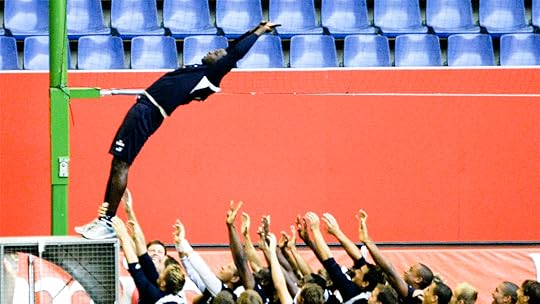
China is the second-largest economy in the world and expected to surpass the US in the next decade. This shift in economic power makes it even more important for Western executives to build successful, high-quality relationships with their Chinese counterparts. But such relationships don’t always come easily. Consider the following examples:
Western representatives of a multinational thought their negotiations with an important Chinese supplier were almost finalized when the Chinese negotiators started asking questions the Western side believed had already been agreed on. It made the Western negotiators feel as if the Chinese side had made no attempt to understand their concerns.
An international company created a platform its R&D centers could use to share their latest developments and discuss any challenges. The idea was to encourage each R&D center to be more pro-active in responding to changing market conditions. However, it became apparent that the Chinese R&D center was hardly participating.
An international head of department based in Wenzhou faced difficulties on a regular basis for his Chinese managers to accept overseas assignments. This international manager was unclear about why some of his Chinese managers were so hesitant to develop strategic relationships with non-Chinese staff elsewhere in the world.
What is the common problem underlying all of these three examples? It all has to do with trust, and how it’s built.
Depending on one’s cultural background, trust may be developed and defined in different ways. I have spent years studying the function trust in business, and have taught business leaders in both the West and in China. It is important to stress that no difference exists between both parties regarding the importance of trust to the development of the business process. All human beings, regardless of their cultural background, have a strong desire to develop relationships, and trust is crucial in this process.
The main differences lie in how people from the West and China work towards building a trusting relationship, which is reflected in what their (dis)trust default is, and how this influences the function of trust is in the relationship being developed. (Of course, people in both cultures are individuals – the patterns I’ve observed in each culture are sweeping, and won’t apply to everyone.)
What is your trust default?
Trust is usually defined as a positive expectation that the other party will act in honest and benevolent ways, reducing fear that one may be exploited. Considering both parts of this can help us distinguish the trust defaults in the West versus China.
Generally speaking, in the West the default is “trust.” I’ll give you the benefit of the doubt, and consider you basically trustworthy until you do something that breaks our trust. In China, the default tilts more toward “distrust” – I only award you my trust after you’ve proven yourself worthy of it. This attitude is illustrated in an eloquent way by the popular Chinese saying that “early birds get shot” (qiang da chu tou niao) – which reflects the strong desire to avoid any social risks. Clearly such an attitude does not invite people easily to engage in a more Western-like trust giving process.
As one Chinese business executive told me: In China you build trust first, once that is achieved, only then you do business. In the West, on the other hand, people are used to doing business almost immediately when they work in the same industry. Westerners feel more comfortable conducting business and building trust at the same time, if the opportunity arises.
As the research of Roy Chua, an associate professor at Singapore Management University, has found, American executives make a strong distinction between trust from the head (i.e. trusting someone because of his or her professional competence) and trust from the heart (i.e. trusting someone because of your relationship with him or her); whereas for Chinese executives both types of trust are needed. These findings emphasize again the need for interpersonal trust to be established and exist before conducting business in China.
What is the initial function of trust?
Where do these defaults come from? To answer this question, we have to examine how people in each culture define the initial function of trust. Put simply, in China the primary function of trust is to protect and establish feelings of safety initially. In the West, it’s more to explore and establish where possible fertile ground for future opportunities.
The West is considered an individualistic culture, in which people need to acquire the skill to build alliances and networks to survive. As a result, within individualistic cultures people have learned to take a more active approach to building relationships, and defaulting to trust becomes the norm. China is not an individualistic culture, but neither is it – as claimed incorrectly by many people – a collectivistic culture. It is a relational culture. Guanxi is a Chinese concept referring to the tight social networks that shape Chinese society. Almost automatic trust exists between people in the same guanxi, but trust is never assumed outside of it. So distrust becomes a default — only if one is certain that a new relationship will not threaten, but rather preserve, the interest of one’s closest relationships, will trust then be given.
In light of building international business, it is clear that from a Chinese perspective you will need to earn trust first before things get moving.
How can Western businesspeople establish trust with their Chinese counterparts?
So, from a Western point of view, how should one approach business situations in China when they involve building interpersonal trust?
Taking time to develop the relationship is a must. Chinese businesspeople will invest considerable time in getting to know you. While you, from a Western point of view, may think you are already discussing business deals, your Chinese counterpart may not even be thinking about the deals that could be made – he or she may still be evaluating you. Although this may be frustrating at times because it seems like business is going nowhere, keep in mind that once you are perceived as trustworthy things will move very quickly.
Because in the initial stages, no personal relationship exists yet, be aware that trying to build trust through mainly social means might backfire. Organizing parties or giving gifts can work against you. Early on, it is more important that you show what your value will be to their business. At this stage it is also necessary to remember that it is most important to demonstrate your competence and expertise rather than just simply talk about it.
Once a business relationship takes off and you are working with Chinese managers and employees, keep building on this foundation. It is important that the Chinese counterpart feels that throughout the business process a sense of benevolence exists, which will make for good business on the long term. Keep in mind that although building trust in China is a highly participative and time consuming activity, the level of trust that can be achieved can be forever. As a popular Chinese saying mentions: Once a promise is made, it cannot be withdrawn, not even with the forces of four horse powers (yi yan ji chu, si ma nan zhui).


[image error]
February 10, 2015
How to Manage Remote Direct Reports
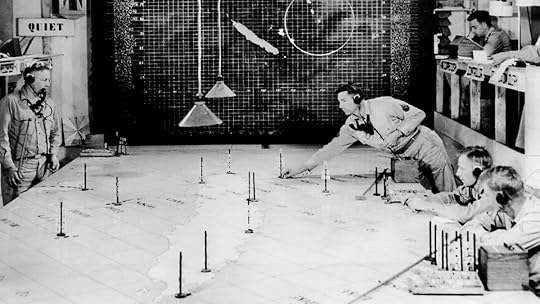
Geographically dispersed teams are increasingly common in the modern workplace — perhaps you’re based in your company’s New York headquarters and your team works out of offices in Denver and Charlotte or maybe you’re in San Francisco and manage telecommuters in LA and a group of developers in Minsk. How do you overcome the challenges of supervising employees in different locations and time zones? What steps should you take to build trust and open lines of communication? How should you establish routines? And how do you help remote workers feel part of a team?
What the Experts Say
One of the biggest misconceptions about managing remote workers is that it requires an entirely different skillset. “We have a tendency to overcompensate and approach remote workers and virtual teams as these mythical beasts,” says Mark Mortensen, an associate professor of Organizational Behavior at INSEAD. “But you shouldn’t think about them in a fundamentally different way. They are still people working in an organization to get stuff done. Treat them as such.” That said, managers must put in extra effort to cultivate a positive team dynamic and ensure remote workers feel connected to other colleagues. It requires a “proactive approach,” says Keith Ferrazzi, the founder and CEO of Ferrazzi Greenlight. So, whether your team is comprised of people in far-flung locations in faraway time zones or employees who work from home (or a combination of both), here are some pointers to keep things running smoothly.
Set expectations
“As the manager, you need to set clear, deliberate expectations in advance and establish ground rules for how interactions will take place,” says Ferrazzi. If you fail to do this, “things will break down immediately.” He recommends “establishing clear lines of accountability” from the outset of the working relationship by setting monthly, quarterly, and yearly performance goals as well as “targets for what ‘hitting it out of the park’ would mean.” Then, just as you would with employees working down the hall, “you should check in regularly on progress” through an agreed-upon schedule. Mortensen adds: be sure to make it clear that you’re “applying the same metrics to the rest of the team.” Remote workers “need to know that they’re not being treated differently and there’s no inequity.”
Visit on a predictable schedule
There are no rules governing precisely how often you need to see your remote workers in person, but Mortensen recommends visiting them regularly especially in the early stages. “If you can get yourself to their location when you first start working together, that’s invaluable,” he says. “Seeing people one-on-one, face-to-face sets the tone and gives people a sense of comfort.” As the arrangement stabilizes, “predictability is more important than a particular frequency,” he says. “If your direct report knows you’re there every six months, it helps build trust.” When you’re at their location, make an effort to “understand their environment and get a sense of what it’s like” to work from afar. “Join in on a conference call to the home office so you can get a glimpse of [the situation] from their perspective,” Mortensen says.
Encourage communication
The key to managing relationships with remote employees, says Ferrazzi, is to “set an appropriate cadence” of communications—including how quickly employees need to respond to email; what follow-up steps should be taken; and on which days check-in calls should occur. “If you, the manager, don’t create good, open communication channels, the remote worker will feel, well, ‘remote’ and forgotten,” he says. It’s also important to establish frequent, recurring team meetings that at least attempt to accommodate everyone’s schedule, he adds. In light of time-zone constraints, it’s considerate to set up the meetings on a rotating schedule so that no one team member or region is unduly burdened or disrupted. Encourage the use of instant messaging, blogs, wikis, and other online collaboration tools and apps. Your team must “understand that they have an obligation” to stay in regular contact, says Mortensen.
Further Reading
Getting Virtual Teams Right
Leading Teams Article
Keith Ferrazzi
Four elements are crucial for success.
Save
Share
Spark impromptu interactions
Unplanned conversations between coworkers are “important for flows of knowledge throughout an organization,” says Mortensen, which is why you — the manager — have a responsibility to “literally create water cooler moments.” Video links between offices “create a shared space and provide more opportunities for these spontaneous — but often very productive” workplace conversations, he says. “It might feel weird the first day it’s on, but by the tenth day, people are more comfortable.” When it’s not possible (or preferable) to have a camera that’s always on, Ferrazzi recommends regular use of technologies like Skype and WebEx. Video technology, he says, “brings us together and connects us, increasing the intimacy of our relationships with one another.”
Nurture familiarity
Building trust and familiarity with your direct reports requires you get to know them on a personal level. With remote workers “this takes additional effort,” says Mortensen. He suggests reserving the first few minutes of calls and videoconferences to simply “chew the fat.” You should talk about “the things you usually talk about at work”— weekend plans, kids, pets, or last night’s big game. Encourage your direct reports to do the same with their remote colleagues. This social bonding “builds essential empathy, trust, and camaraderie,” Ferrazzi says. “What binds together virtual teams are the personal details.”
Make them feel part of the team
Physical distance can sometimes create an “us versus them” feeling. Mortensen says it’s critical that you “watch the language you use when talking about remote workers and make sure you’re not creating fractures within your team.” Concentrate on what you and your direct reports have in common — organizational goals and objectives, for example. Remember, too, that remote team members often feel somewhat invisible and “that their actions and efforts aren’t noticed.” Being generous with public praise and acknowledgement of remote employees helps “make sure their work is recognized” and is a signal to “coworkers that they’re pulling their weight,” says Mortensen.
Principles to Remember
Do
Get to know your remote reports on a personal level by reserving a few minutes during meetings and calls for casual workplace conversations
Establish a schedule of communication both between you and your remote employee and between the remote employee and the rest of the team
Use video technology to spark spontaneous interactions among your team members
Don’t
Evaluate the job performance of remote workers differently from the way you assess co-located colleagues — apply the same metrics across your team
Worry too much about setting up constant in-person meetings with your remote workers — predictable visits are more important than frequent ones
Forget to acknowledge the work of remote workers so their efforts don’t go unnoticed
Case Study #1: Unite employees around a common goal
Arvind Sarin, the co-founder and CEO of Copper Mobile, a mobile app development firm, manages over 100 employees split between the company’s headquarters in Dallas, Texas, and its office in Noida, India. The majority of the company’s clients are in North America. Because of the difference in time zones, there was some resentment between team members. “There was still a feeling of: ‘Oh, that team over there rolls out at 6pm while we’re here working late into the night,’” he explains.
To mitigate the building resentment and bring the team together, Arvind decided to be more open about the company’s overarching goals and financial targets. He took a new approach with a big project Copper Mobile was working on for an LA-based dating company. “In order to get everyone on the same page, I painted a picture of our strategy so that everyone — from developers in India to the leadership team here — would know what we’re doing,” he says.
His aim was to “lay it all out” for employees in both offices “so that everyone knew what to expect” and felt bonded by a common goal — to successfully execute the project. In a series of meetings, “we explained how much revenue this client would bring in, what the billing rates would be, how long we expected the engagement to last, what the workflow would be like, and how we viewed this customer as a strategic client.”
Arvind’s transparency about the project united the team and motivated employees to work together. The project was a big success. “When you don’t give people information, they assume the worst,” he says. “Restating our vision and reminding people of what we were trying to achieve helped a lot.”
Case Study #2: Seize opportunities for in-person team bonding
Manon DeFelice, the founder and CEO of Inkwell, a specialized professional staffing company, manages an entirely virtual team.
At the moment, she has eleven employees — all of whom work from home — spread across the US. Recruiting and business development are run out of New York; legal is in Washington, DC; she also has colleagues in Austin, Miami, and Minneapolis. Manon herself is based in Connecticut. “Because we’re a virtual team, we don’t have that daily office chitchat,” she says, adding she has to work hard to make sure she is close to her colleagues and that everyone on her team “feels connected to, and trusts, each other.”
To encourage bonding, Manon tries to seize every opportunity to gather the group together face-to-face. She recently had a big pitch meeting in New York City. Instead of enlisting the help of only local employees, she invited everyone on the team to the City and then took them all out for celebratory dinner. “We are not renting expensive office space so I like to spend money taking my team out to nice restaurants. I want people to get to know each other — to talk to each other about their kids and their spouses—just as they would if they worked in an office together.”
Another way Manon lifts team morale is by being generous with praise. She regularly sends company-wide emails praising the team and singling out colleagues for a job well done. The emails, she says, provide public validation. “In an office, your boss might call to you from down the hall and say: ‘Awesome job on that project!’ and your colleagues would hear that and know you’re working hard.” Remote workers, though, don’t have that happen. “So I do public thank-you emails, and CC others as a way for them to ‘eavesdrop’ on the conversation.”


[image error]
Project Manage Your Life
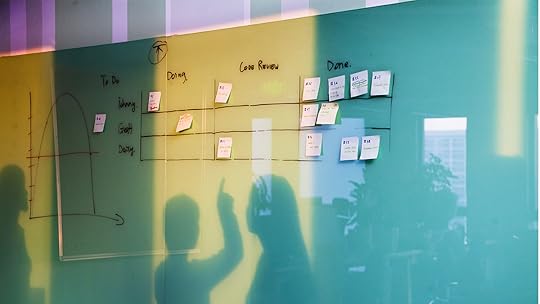
More and more companies are adopting software and product development frameworks like Agile, Scrum, and Kanban — which promote quick, iterative, lean production — to deliver higher quality products, faster. These methods help teams produce rapid, continuous improvements, via daily face-to-face communication and visual workflows.
If these methods can help teams get on the same page, streamline tasks, and reach collective goals more quickly, can they also help people be more productive in their personal lives? I recently spoke with Frank Saucier, executive and Agile coach at FreeStanding Agility, about how he applies these methods in his home life. (Disclosure: He’s taught and coached many teams at HBR on how to use these same practices.) An edited excerpt of our conversation follows:
What made you decide to try some of these work solutions at home?
Much of my work involves coaching teams to be more high-performing and self-organizing. My wife and I had a discussion about how our family of five is a team, and that we might benefit from similar approaches.
What specific productivity practices have you brought home to your own family?
Quite a few:
Visual Boards
I use a Personal Kanban approach to manage the flow of my work and household agendas. As a trainer, coach, and consultant, there’s a good mix of work, client, home, family, and personal items that are constantly in competition for my attention. The board helps me keep tabs on everything and keeps things flowing — it’s all about being effective and focusing on the right thing at the right time. It looks like this:
When we’re teaching teams the invisible work of software development, the Kanban board on the wall makes it all visible. The wall becomes the work, and helps us learn habits like what to do when something gets visibly stuck in a to-do column. That translates well to home, too. We use columns like “To Do,” “Doing,” and “Done” — or sometimes days of the week. We ideally would want to see a sticky note move in the course of a day, so we have what’s called “flow.” This allows you to actually see progress, and conversely, to see when something is “stuck.”
My kids love the tactile approach of grabbing a sticky, and adding it to the board. For instance, they might put “go bowling” in our weekend column. It helps the whole family learn to incorporate new ideas, negotiate, compromise, and communicate.
Family Meetings
When we use Scrum with teams at work, we are often in a 2-3 week cycle, holding “retrospectives” to keep us all on track. Our family meetings are a lot like a retrospective, where we cover the things that are most important for us to be working on. My wife and I hold a family meeting every other weekend, and we use an agenda template that includes:
A check in on emotional states (mad, sad, glad, afraid). It’s important to do this at the start of the meeting — the point is to simply have people be present, and to have the space to say if they feel off, and why.
A section for each person to give compliments to others they appreciate. This helps reinforce positive behaviors.
A chores section, so we can all sign up for things that need to be done around the house, and be held accountable for them each week.
A list of issues that we need to discuss as a family (for instance, the chores from the last family meeting weren’t done, school projects the kids are working on, priorities for the upcoming week, etc.)
Our 7-year-old has taken to using the agenda sheet to facilitate the meeting, which is teaching him good communication skills.
Daily Check-ins
We try to have at least a couple of regular check-ins during the day. First, we try to eat dinner as a family. We ask each other about what we did that day, what we liked, any mistakes we made, etc. The second check-in is between my wife and me. After the kids are in bed, we step into the kitchen and talk about our day and what’s in store for the next one.
Weekly Planning
Every Thursday, after the kids are in bed, my wife and I meet in the kitchen and talk about two things: plans for the weekend, and the following week’s schedule, and what we need to do to coordinate it all.
Desktop Background
I recently started an experiment using a background graphic on my computer that has the following boxed areas on it: To Read; Reading; Use; Reference; Keep. I have an area in the center that contains my trash icon. I move icons to the respective areas as I work to see if organizing my files and bookmarks according to how I need to interact with them helps me get through more things. It’s an experiment, but it’s already paying off in terms of helping me be more efficient.
Plus/Delta
I also use a quick feedback approach called Plus/Delta at the end of a busy day, after a key event, after teaching classes, after facilitating events, etc. I basically pull out a piece of paper and draw a line down the middle. At the top of the left column, I put a plus sign. At the top of the right column, I put a delta symbol to represent change. In the plus column, I write down all the things that I did well and that went well. In the delta column, I write down all the things I would do differently in hindsight. It’s basically a reflection technique for learning and quickly getting closure.
Expense Boxes
Roughly once a quarter, my wife and I play a game where we list out all the potential expenses that we know are coming. That could be anything from the car needing new tires, to vacation plans, to new shoes for the kids. We then place the items on a sheet of paper with four quadrants: High Importance, Low Importance, High Cost, and Low Cost. This helps us get on the same page about which expenses we need to make to meet our goals.
Further Reading

Getting Work Done (20-Minute Manager Series)
Leadership & Managing People Book
12.95
Add to Cart
Save
Share
That sounds like a lot. How much time does all of this take?
It’s actually really fast. The biggest piece is setting up these systems, but you don’t have to get it all right out of the gate because it’s a process that’s meant to evolve. Every day, I look at what I have on the Kanban board for the day, and make last-minute decisions about what really needs to be done — that literally takes five minutes. It kind of equates to daily standups for teams, where at the end of an iteration or sprint, you have a block of time to go deal with things. What takes more time is stopping to look to all the things that you can’t get to. Knowing that if it’s not on the board, it’s not going to get done that week forces you to prioritize.
Was it hard to get your family on board with these techniques?
There was, and still is, some moaning and groaning, but that’s OK. We’re trying to teach our kids that the family thrives when we all contribute and collaborate. It definitely empowers the kids to know that decisions are not just being handed down from on high, and it lays a foundation for good organizational habits.
Some of this sounds kind of low-tech. What happens when you’re not in front of the wall? Are there digital tools that work just as well?
I like to use low-tech tools, because it’s more important to learn good habits than it is to learn to use a tool. That said, there are plenty of digital ways to do the same thing — a good, free tool is Trello, which is essentially an online Kanban board. But, I find that with digital tools, a lot of great ideas get buried, and the simple act of moving a post-it across a visual board is very kinesthetic. I’ve also noticed that teams have better discussions when they’re around a physical board.
How has using these tools changed your family life?
There was an immediate benefit to seeing all that stuff laid out in one place. It’s made visible a much larger list of everything that we need to do — of all the pressures that we have on us as a family, and as parents. It’s helped us realize why we feel overwhelmed. When we saw exactly how much was on our plates, it forced us to make decisions on what we value.
It’s also helped us get on the same page with schedules, coordinating the family, and upcoming priorities. Very little falls through the cracks now.
Are there places where it falls apart?
It can be tough for young kids to stay focused for a family meeting. We keep it to 15 minutes or less, offer treats, cover the table with white paper and put out markers, and try to do a family activity at the end of the meeting. We also allow our 5-year-old to be done first and walk away when he needs to.
Has the increased organization at home affected your productivity at work?
It’s absolutely helped me focus on the most important things to spend time on while I’m at work. We all have limited bandwidth, and we’re bombarded with distractions that each scream that they’re the most important thing — but they’re not always. So, we have to be very good at discerning when to accept the interruption, which means knowing what’s most important — at home, and at work.


[image error]
Why Sprint and Radio Shack Are Shacking Up

RadioShack’s post-bankruptcy life in a retail partnership with wireless carrier Sprint seems like an unlikely marriage. But it could be the best way forward for the two brands, which have each faced their own challenges. RadioShack has long suffered from unfocused positioning, while Sprint has wrestled with customer retention issues and acquisition pressure in a market dominated by cellular giants AT&T and Verizon. Joining forces could breathe new life into both brands.
The plan is for hedge fund Standard General, RadioShack’s lender and largest shareholder, to buy up to 2,400 of RadioShack’s roughly 4,000 stores and team up with Sprint to transform 1,750 of the acquired stores into cobranded Sprint-RadioShack locations.
The Sprint-branded store-within-store centers would carry Sprint brands, including Boost and Virgin Mobile, and occupy about a third of the space, leaving the remainder to RadioShack. Sprint would be the primary brand on the stores and marketing materials.
This deal allows Sprint to expand its distribution fast. Sprint must have had a good sales record in RadioShack stores to consider this partnership, and the brands’ prior wholesale partnership should ease the transition. The deal will let RadioShack live on in a portion of its current locations. To be sure, there are challenges for both brands. For Sprint, it’s the scale of the expansion, its low-price and thus lower-margin strategy, and the saturated and fiercely competitive wireless market. For RadioShack, it’s figuring out its new positioning. While its entertaining and clever 2014 Super Bowl commercial tried to shake off the impression the retailer was stuck in the 80s, it couldn’t capitalize on the positive reception.
Sprint holds third place among U.S. wireless companies, far behind AT&T and Verizon and just ahead of T-Mobile. An expanded store network could help accelerate its customer acquisition efforts and catch up with its competitors on the size of their distribution networks. The deal would more than double Sprint’s current network of about 1,100 company-run stores. It is in line with Sprint CEO Marcelo Claure’s recent announcement to “grow [Sprint’s] distribution dramatically.” It may also support his determined pursuit of the Hispanic market. (A Bolivian native, Claure starred in a recent Sprint ad in Spanish). Claure has pointed out RadioShack’s “incredible store locations” so Sprint must have done its due diligence in gauging the fit with Sprint’s target market.
Given Sprint’s low-price positioning, volume is its main lever for generating profits. Since his arrival in August, CEO Claure has been trying to increase Sprint’s market share with aggressive pitches such as the “Cut Your Bill in Half” promotion (which provides data at half the price of AT&T and Verizon) to lure away AT&T and Verizon customers, fee cuts on select plans, increased data, and an “iPhone for Life” annual update plan.
Customers responded to the promotions—Sprint acquired almost one million new customers in the latest quarter—and store traffic increased, so much that wait times to get a phone can be an “unacceptable” one to two hours, according to Claure. The new stores could mitigate the lines.
The new locations could also help with customer acquisition and retention, which are top goals for Sprint. In the cell phone business, a solid off-line presence makes good sense, allowing customers to explore products and get in-person help and repair services. Unlike the dominant market leaders AT&T and Verizon, Sprint (and T-Mobile) have more prepaid customers—and fewer postpaid customers in long-term contracts—which intensifies the constant worry about attracting and keeping customers. In 2014, Sprint lost 2.3 million postpaid customers while each of its three main competitors gained between one to four million. Sprint (and T-Mobile) customers are generally less loyal than AT&T’s and Verizon’s, according to a recent survey.
With the cobranded stores, RadioShack and Sprint want to leverage cross-marketing benefits. For the two brands to maximize their partnership’s value, serving similar customers would be ideal. This presents an interesting challenge, given that Sprint’s positioning is low price and value while RadioShack’s positioning has been unclear for some time—and was a contributing factor in its bankruptcy or “slow motion collapse,” as Bloomberg called it.
A key question is what the iconic RadioShack brand means to people now and what segments there are with distinct brand associations. RadioShack was founded almost a century ago as a one-store and catalog specialty retailer of the latest electronics and parts with expert service for a niche segment of hobbyists, tech nerds, and early adopters. It has recently lost its clear differentiation and focus while trying to respond to the changing electronics landscape (commoditized and dynamic), consumer make-up (fewer hobbyists, builders, less fixing and more replacing), and competitive climate (including online and price competition).
In an effort to follow the market, RadioShack turned its focus to cell phones but lost business to competitors, including Amazon, Best Buy, and Walmart. With the new Sprint-RadioShack stores’ cell phone business run by Sprint, RadioShack will need to shift its focus to other categories and figure out its future positioning. Obviously, RadioShack had little choice but to make major changes. The new arrangement with Sprint should help it regroup and reposition in a downsized form.


[image error]
Marina Gorbis's Blog
- Marina Gorbis's profile
- 3 followers


